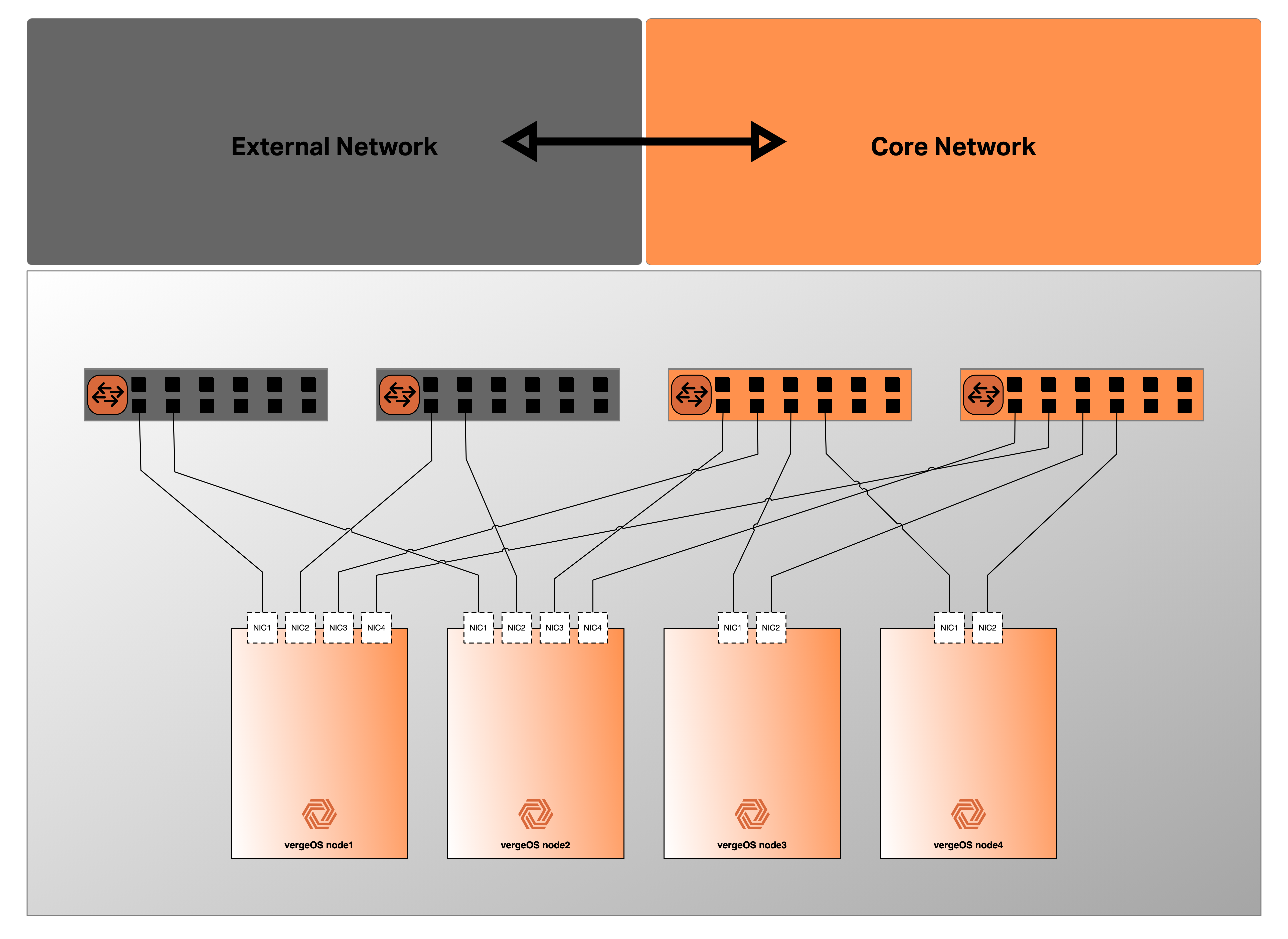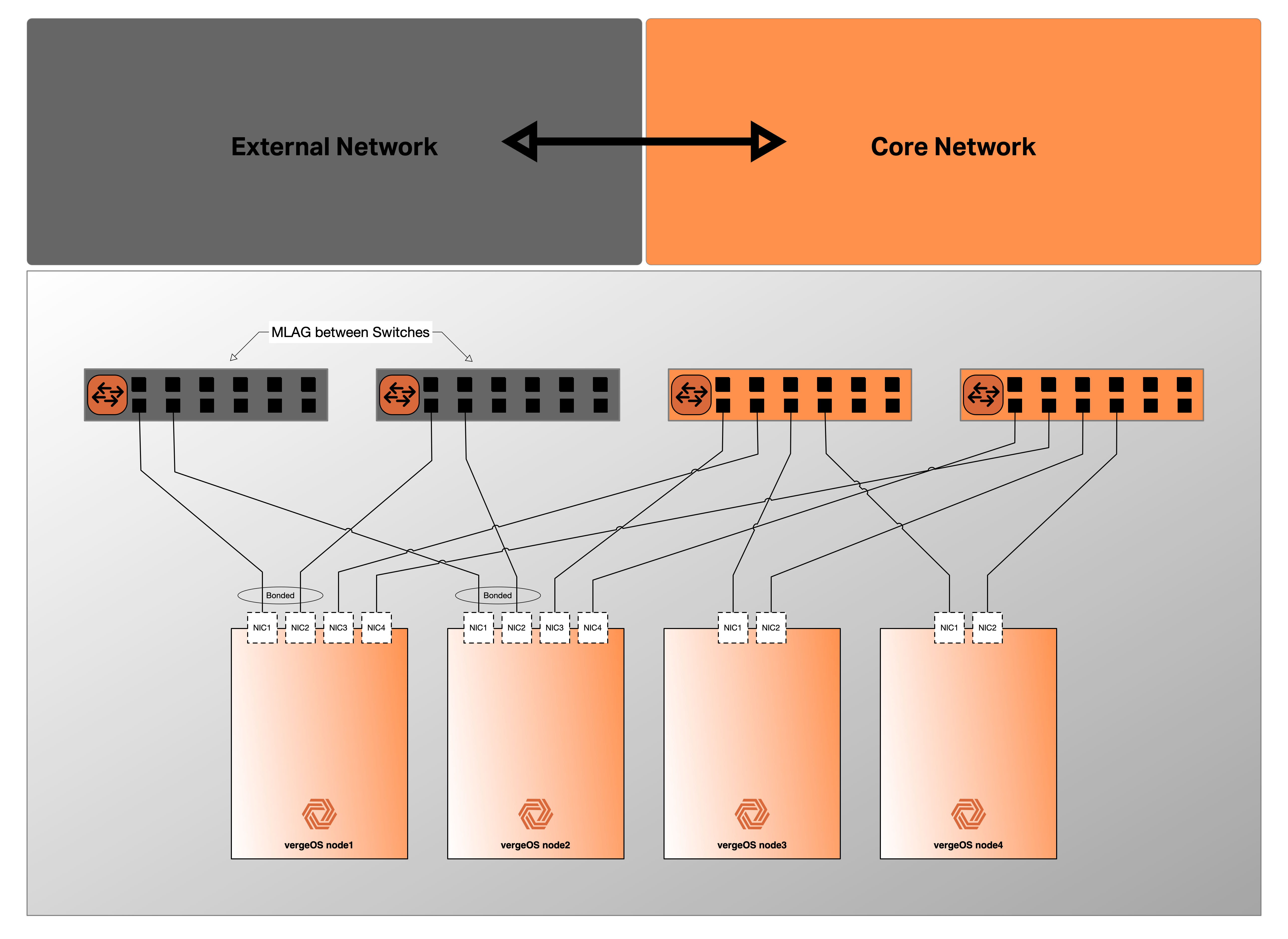Network Design Models#
Please review the core concepts first to learn more about VergeOS Network types before reviewing this document.
The following network models are designed for redundancy
Generic Requirements (All network design models)#
For environments with more than 2 nodes, switches are required for Core Fabric Networks
Core Fabric Network Requirements#
-
Jumbo Frames configured on all Core Fabric Network switchports
- Minimum MTU size 9000
- Recommended MTU size of 9216 and above
-
Broadcast traffic allowed between nodes
- Core Fabric Networks 1 and 2 on their own dedicated layer 2 networks
- The Core Fabric Networks for VergeOS Systems located in the same site need to be completely isolated from eachother
- Network latency between nodes on Core Fabric Networks should be <0.05ms (no switch hops)
Core Fabric Network - No Switch Hops Between Nodes
All nodes must be connected to the same switching fabric with zero switch hops between them. Adding switch hops in the core fabric path will introduce latency that can significantly impact cluster performance and stability. This requirement applies to all Core Fabric Networks.
External Networks Requirements#
-
Standard MTU (1500) configured on all External Network switchports
- Jumbo frames (9000-9216) optional if required by workloads
-
External Networks configured as VLAN trunks (802.1Q tagged)
- Multiple VLANs allowed on trunk ports for workload/tenant separation
-
LACP (802.3ad) bonding recommended for redundancy and bandwidth aggregation
- Active-backup bonding supported as alternative
-
Network latency <1ms acceptable for most workloads
- Routable to upstream networks (gateways, internet, other infrastructure)
- Spanning tree protocol allowed (standard Layer 2 operation)
Layer 2 Static + Dedicated Core Fabric#
This model uses a bonded Layer 2 network for the External, UI and API Management Networks, while maintaining dedicated Layer 2 networks for the Core Fabric traffic.
Use Cases#
- High performance production environments
- Existing VMware environments using a Distributed Switch
- Environments where you want to deploy VMs directly in VLANs that are External to VergeOS
Requirements#
- 4 x 10/25/40/100GbE network ports per node
- Switching infrastructure that supports stacking (MLAG) - For External Network
Network Configuration#
-
4 VergeOS Physical Networks:
- Core Fabric Network 1
- Core Fabric Network 2
- External Network 1 - Primary bond
- External Network 2 - Secondary bond
-
Core Fabric Networks 1 and 2 on their own dedicated layer 2 networks
- A single VLAN for UI/API Management (on primary bonded External Network)
- Any other VLANs required for your workloads (on primary bonded External Network)
Diagram#
Layer 3 Dynamic + Dedicated Core Fabric#
This model uses dynamically advertised Layer 3 networks for the External, UI and API Management Networks, while maintaining dedicated Layer 2 networks for the Core Fabric traffic.
Use Cases for L3+DC#
- High performance production environments
- Large-scale deployments
- Environments requiring advanced network segmentation
Requirements#
- 4 x 10/25/40/100Gb network adapter ports per controller node
- A layer 3 network External to the System that VergeOS can peer with
- BGP, OSPF, or EIGRP capabilities
- Using VergeOS Internal Networks for workloads
Network Configuration#
-
4 VergeOS Physical Networks:
- Core Fabric Network 1
- Core Fabric Network 2
- External Network 1
- External Network 2
-
Core Fabric Networks 1 and 2 on their own dedicated layer 2 networks
- A single dynamically advertised network for UI/API Management
- Any other dynamically advertised networks required for your workloads
Diagram#
Layer 3 Static + Dedicated Core Fabric#
This model uses a bonded Layer 3 network for the External, UI and API Management Networks, while maintaining dedicated Layer 2 networks for the Core Fabric traffic.
Use Cases for L3+DC#
- High performance production environments
- Large-scale deployments
- Environments requiring advanced network segmentation
Requirements#
- 4 x 10/25/40/100Gb network adapter ports per controller node
- Switching infrastructure that supports stacking (MLAG) - For External Network
- Layer 3 capable switching infrastructure for the External network
- Using VergeOS Internal Networks for workloads
Network Configuration#
-
4 VergeOS Physical Networks:
- Core Fabric Network 1
- Core Fabric Network 2
- External Network 1 - Primary bond
- External Network 2 - Secondary bond
-
Core Fabric Networks 1 and 2 on their own dedicated layer 2 networks
- A single statically routed network for UI/API Management
- Any other statically routed networks required for your workloads
Diagram#
Layer 2 Static using 2 network ports#
In this model, all networks (Core Fabric, External/Management, Workloads) are combined into a single bonded network VergeOS Physical Network.
Use Cases - 2 network ports#
- Proof of concepts
- Small Edge deployments
- Disaster recovery setups
- Development workloads
- Bare Metal Cloud Providers
Each statically assigned network you route to VergeOS in this system design will be non-redundant
Requirements - 2 network ports#
- 2 x 10/25/40/100GbE network adapter ports per node
- Ability to trunk VLANs and set a native VLAN on switch
Network Configuration - 2 network ports#
-
2 Physical Networks
- Core Fabric Network 1
- Core Fabric Network 2
-
All networks VLAN tagged
- Core Network VLANs set as native
- A single VLAN for UI/API Management (Either Core Fabric Network)
- Any other VLANs required for your workloads (Either Core Fabric Network)
Diagram - 2 network ports#
By choosing the appropriate network design model based on your specific use case and requirements, you can ensure optimal performance and scalability for your VergeOS deployment.



